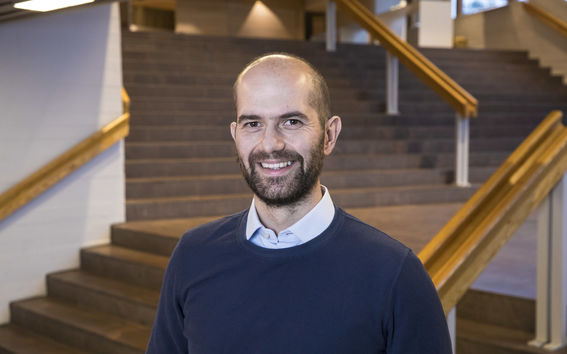Finding solutions to clinical problems

What kind of research do you do, and why?
Through my work, I am hoping to provide engineering solutions to essential clinical problems. I guess that my research can then be described as basic science with a high translational motivation. Essentially, I am investigating engineering techniques for human-machine interfacing in order to support, augment and rehabilitate human motor function. Through basic physiology, motor control, and biomechanics, I explore novel biosensing and control approaches, as well as design methodologies in order to push the boundaries of current state-of-the-art bionic limbs, exoskeletons and rehabilitation robots. In other words, as my oldest nephew recently concluded - I am building robots to help people play again.
How did you become a researcher?
Becoming a researcher was not something I have set up as a goal, but I believe that it came as a byproduct of pursuing my own curiosities. At the end of my master degree studies, I started working in prosthetics industry as an engineer, but a few years later, I had accumulated a sufficient number of “whys” and “what ifs” that prompted me to head back to grad-school. However, upon finishing my PhD, I have realized that while answering some of those initial questions, I generated a whole set of new ones and academic environment seems to be the most suitable place to pursue this newly formed passion.
What are the highlights of your career?
My career has been residing in a cross-section of three main pillars – scientific advances, clinical needs and industrial applications. Having those in mind, I see the highly interdisciplinary project that was concluded in 2017, as a result of an immense effort of a very diverse team, as my biggest accomplishment so far. I started pursuing that specific work while I was still working as an engineer in a company, and over the next six years, it remained my passion throughout my PhD and a better part of my postdoctoral research. The most significant results got published in Nature Biomedical Engineering journal, which brought to me, as one of the key members of the team, an immense professional validation, and, moreover, acknowledgment that all the personal efforts, career choices, and tests of character that I had to face and go through, were worth it. In addition, kind words of reassurance from the patients in need who we managed to excite with the technology we were working on, were an inspiring award of its own.
What is the most important quality for a researcher?
Curiosity combined with the tenacity and perseverance. And not only in the respective field of work, but rather in everything and anything. Regardless of how mundane or flamboyant the topic or the question might be. This way researcher remains continuously intrigued about the world and inspired to find new and exciting solutions and approaches to the exciting puzzles around him/her.
What do you expect from the future?
Personally, I hope my work will broaden our overall knowledge in the field of my choosing and make a direct positive impact on our society. By exposing my students to the challenges of applied engineering and by equipping them with necessary tools and mindset for finding the solutions to the interdisciplinary questions of tomorrow, I hope to help breed and inspire a new generation of professionals capable of shouldering the societies of the future.
- Published:
- Updated:
Read more news

This is how smart textiles can look like: self-cleaning cotton or a colour-changing print
An article by YLE Svenska about 'Beyond e-Textiles' project and 'Interlaced' exhibition at the University of Turku
Ammonia – a new green energy solution? Research project receives €2.5 million in funding
Ammonia is a promising alternative fuel for the marine industry and for storing green hydrogen, but there are many question marks over its use.
A new project in Espoo aims to improve disparities in children's learning outcomes – with the goal of preventing social segregation
Supporting children's learning skills has a major impact on their further education and employment, among other things.